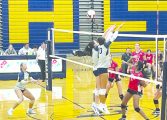Like all Rosenwald schools, Dunbar was built to specifications established by the fund. According to a database of schools maintained by Fisk University in Tennessee, it cost $2,600 to buy the two-acre lot on Mountain Hill Road and construct the building in 1923-1924, with $700 coming from the fund, $1,400 from the county, and the balance from the local community. Built on floorplans supplied by the fund, the two-classroom structure was bright and airy, with rows of tall windows to let in the light, a must in an era when few rural schools had electricity.
Dunbar, like other Rosenwald schools, closed in the late 1950s after the opening of Central Elementary School. It went on to become a church and later a shop and private home before it was finally left empty about 20 years ago. Smith said it was in rough shape when she decided to take on the project, with vines covering what was left of the old windows and chunks of sheetrock falling from the ceiling.
While still working full-time for Northrup Grumman, repairing the building became a weekend and holiday project for Smith and her husband. They pulled out the sheetrock and rotted wood and put in new windows. Everything got fresh coats of paint and polish. “Sometimes we may only say two words to each other all day, each working on something at opposite ends of the building,” Smith laughed.
It was a project they’ve done mostly out-of-pocket, one window and one gallon of paint at a time. Smith considered applying for historic preservation status, a designation that would have opened up more funding possibilities, but she worried that it might limit her ability to turn the building into what she wanted it to be: a community gathering space for the Mountain Hill neighborhood.
Officially opened in February, Dunbar School looks to the future without forgetting the past. There’s a modern bathroom, a small kitchen and wifi. There’s a large open space for social events and meetings, a small exercise room, and another room for teens to hang out with computers and phones. Smith lined the teen room with comfortable chairs and even tacked up a green screen so the kids can make fun videos. Someday, they hope to install an outdoor basketball court.
The other end of the building has been made into a small museum of sorts, filled with antiques and mementos Smith has collected over the years. One local gentleman donated his collection of books on African American history, and even threw in the shelves. Smith has gathered photos of almost all of Fluvanna’s black churches. Photos of local African American veterans are lined up along the shelves. The space is always evolving as Smith finds new items to display.
As they set up for the STEM meeting, one of Smith’s colleagues suggested they split the kids into two groups and asked if she could use the old classroom to show the younger kids her presentation on Newton’s Laws. She asked if it was okay to use some small paper rockets as part of her demonstration. “Oh sure,” Smith said. “Rockets aren’t going to hurt this place.”




